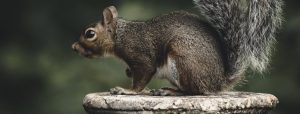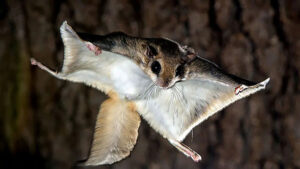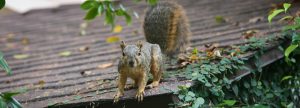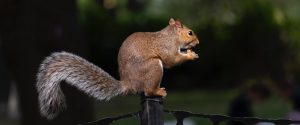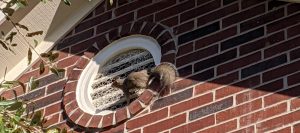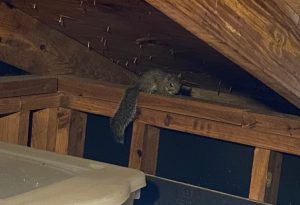At Trutech Wildlife Service, we have seen it all as far as squirrel pest control. Homeowners often try various methods to get rid of squirrels in their attics, from scent deterrents to ultrasonic devices. Unfortunately, these methods are rarely effective.
The Reality of Squirrel Infestations
By the time you notice a squirrel infestation, the squirrels are well established in your attic or in the walls. It is a very good possibility that a single squirrel found in the attic (especially during breeding season) will be a female looking for a nesting area. During non-breeding months there may be multiple squirrels in the attic.
There can be two breeding seasons for tree squirrels. The most common times are in early spring and early autumn.
If a breeding female has been in the attic any length of time they may have already nested and given birth. Weaned squirrels will remain with the mother for some length of time thus stay in the attic.
The survival and nesting instincts of squirrels are incredibly strong, and they won’t leave just because of an unpleasant smell or noise.
Scent & Ultrasonic Deterrents
There are many claims of deterrents that work for squirrel pest control. There are multiple ultrasonic devices on the market and numerous squirrel control articles with DIY scent solutions. None of them work.
Squirrels usually always stay near the edge of the attic anyway, near a well-ventilated soffit, and the scent odors just don’t help because of this.
In addition, the entire attic is too well ventilated using ridge vents, attic fans, gable vents, and other ventilation. I have even seen the very cotton balls soaked with the deterrent scent incorporated into the nest in the attic. Research has confirmed the ineffectiveness of scent deterrents and ultrasonic devices.
Light/Strobe Repellents
The practice of leaving a light on, or using a high-intensity light often isn’t annoying enough and the squirrels get used to it. If there’s a strobe light, they may move to another spot in the attic or just end up somewhere else in your home such as the walls.
Either way, squirrels are not going to leave an attic because of lights, most especially if they have already nested and young squirrels are present. Besides, the lights will have to be connected into existing wiring and/or batteries/bulbs changed etc. Crawling around in the attic is NOT fun and doing so repeatedly is even less so.
Let’s reiterate this, squirrel repellents such as light/sound/scent deterrents don’t work effectively. They certainly don’t work to evict an animal that has already moved in. To solve the problem, the squirrels have to be removed from your attic and around the property.
Let's reiterate this, squirrel repellents such as light/sound/scent deterrents don't work effectively. They certainly don't work to evict an animal that has already moved in.
Squirrel Removal Services
At Trutech, we use a few different squirrel removal methods. Our goal is to remove the pest squirrels as humanely and quickly as possible. The best squirrel removal is a squirrel trap, an excluder device, or both used in conjunction.
Full Home Inspection for Squirrels
If you have a squirrel problem, we inspect your roof and attic for entry points, squirrel damage, and squirrel nests.
We need to seal all entry points for eco-friendly squirrel control solutions. We also cataloged for damage caused by the squirrel. squirrels in the attic are known for gnawing electrical wiring and thus creating an imminent fire hazard. Any damaged wiring needs to be repaired immediately. Look closely for structural damage and repair as necessary. Squirrels are notorious gnawers.
Squirrel Traps
Squirrel trapping is one of the safest and most effective squirrel removal strategies.
The best squirrel trap is to use a 5- x 5- x 18-inch (minimum) cage or box traps. Box traps are built with solid walls usually of wood, plastic, or sheet metal. Cage traps are made of wire mesh. For squirrels, use a cage trap from ½- x 1-inch mesh.
Both live traps can in either one-door or two-door traps. Snap traps, mouse traps, and glue traps will not work on most squirrels.
Excluders
Once the entrance hole is discovered an exclusion device can be used temporarily to seal the hole. This exclusion door can be bought commercially or made. This device is simply a one-way door that will allow the squirrels to come out of the attic but not go back in.
How Trutech Gets Rid of Squirrels
We typically use a cage trap in conjunction with an excluder. It is a one-way door that allows the squirrel to exit but prevents the return. In these circumstances, we check the trap regularly to safely release the squirrel.
If there are baby squirrels present, we safely remove them after the female has been excluded. Otherwise, you’ll just have a nest full of baby squirrels in the attic which will die of starvation if the mother squirrel on the outside can’t get back in because of the exclusion door. We will hand remove the squirrels and partner with a local wildlife rehabilitator.
Exclusion for Squirrel Control
Once you have gotten the squirrel(s) out of your attic/building, you must do everything that you can to keep them out. You will need to make certain your home or building is properly sealed. Without appropriate/proper sealing, you are letting not only squirrels into the attic, but possibly other wild animals too.
Squirrel trapping solves the immediate squirrel infestation. Your home has already been shown to provide ample resources for squirrels. Without exclusion, you are still at risk for future squirrel infestations.
Because squirrels only need a small entry point, finding all the potential weak spots takes skill and experience.
Exclusion methods keep squirrels and other nuisance wildlife from entering your home. Sealing all vulnerabilities in your roof, soffits, eaves, vents, and chimney is also important.
Squirrel Pest Control in Your Yard
It is impossible to eradicate squirrels in your yard. But making your yard less inviting to squirrels can help protect your house from squirrel problems. Limit access to food, water, and shelter.
Use squirrel-proof trash cans and ensure they are tightly sealed.
Regularly clean up fallen seeds, nuts, and fruit from trees and bird feeders to reduce food availability.
Use compost bins with secure lids to prevent squirrels from accessing compost piles.
Use chicken wire or hardware cloth to protect specific plants or areas, such as flower beds or vegetable gardens.
Reduce standing water sources, such as birdbaths or ponds, which can attract squirrels.
Regularly check for and remove any potential nesting sites, such as piles of leaves, debris, or hollow trees.
Prune tree branches that are within six feet of your roof.
Bird Feeders
Bird feeders are one of the top squirrel attractants in your yard. If you have a bird feeder follow these steps:
Place bird feeders away from trees, fences, and other structures that squirrels can use to jump onto the feeders.
Install baffles (cone-shaped devices) on feeder poles to prevent squirrels from climbing up.
Use squirrel-proof bird feeders designed to keep squirrels out while allowing birds to feed.


